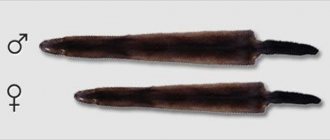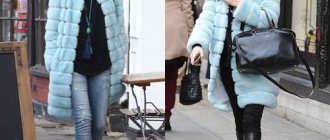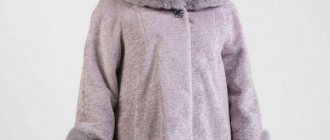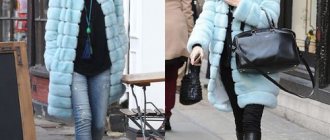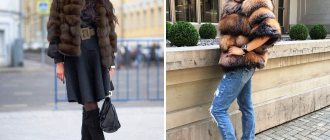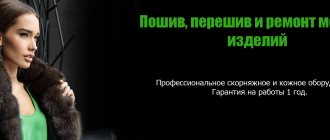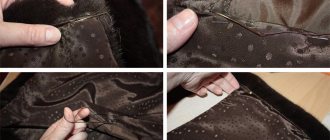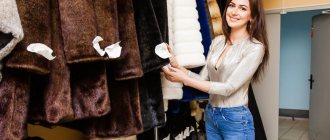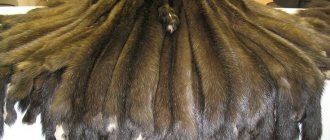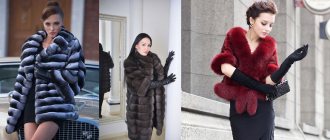For many centuries, women's favorite type of winter clothing has been a fur coat. Some have several, and the owner changes the fur coat at the behest of her heart, while others have none, remaining only an object of desire. But both of them are ready to try them on again and again.
For a harmonious image, it is important not only what kind of fur the fur coat will have, and not only the cut that suits the figure. A very important element of a fur coat is the sleeves.
Based on the cut, the following types of fur coat sleeves can be distinguished:
- straight sleeve: narrow and wide;
- short sleeve: mid-shoulder and 3/4;
- bell sleeve;
- detachable (sleeveless fur coat).
Balloon sleeve
One of the season's favorites. Do you remember what kind of shirts knight-princes used to wear: with wide sleeves and a cuff on the wrist? Or the ladies of the court - dresses with crinolines and wide balloon sleeves? Now fur coats with such sleeves are in fashion. A wide sleeve gathered at a wide, or often narrow, cuff. Or just with an elastic band. This type of sleeve is also called “drop”. It looks undeniably original. This shape is very feminine and comfortable: the wind does not blow, and the image is given romance and sophistication.
Mink coat styles
When choosing a fur coat, women are often interested in the relevance of a particular model, since they have already decided on the style. If this question is still of interest to the buyer, then it should be selected by trying on. This way you can most accurately see how this or that fur coat will fit your figure, match the color of your skin, hair and makeup preferences.
Beautiful fur coat
There are not so many styles, but there are a huge number of models, which are replenished every season thanks to the work of creative, talented designers.
Three-quarter sleeve
This is a sleeve just below (less often just above) the elbow. As a rule, such sleeves have a wide cut. They are also sewn in such a way that they look as if you have a fur coat, like a shirt, with the sleeves slightly rolled up. Also, a strip of leather or other fur is sometimes sewn onto such a sleeve.
Cute, but not very practical. Therefore, if you decide to buy such a fur coat, keep in mind that you can’t wear things with short sleeves under it, it’s better to wear something warm: a turtleneck, a sweater. And preferably with a narrow sleeve that fits the arm. Since this sleeve length is extremely popular this season, long gloves have been specially designed for it, reaching to the elbow or even above it. And, by the way, this form of gloves is also a hit of the season. So, by purchasing long gloves and a short-sleeved fur coat, you will undoubtedly become the most fashionable lady this winter!
Choosing the length of the fur coat
Women choose any clothes based on the advantages and disadvantages of the figure they have.
For full
For plump fur lovers, the best option would be floor-length fur coats with cutouts on the sides to the knee. You can also give preference to an A-shaped fur coat that reaches your hips; this cut will highlight your beautiful legs. Choose furs that are not too long-haired, this will visually lighten your look.
For ladies with a large bust and narrow hips, it is better to purchase fitted fur coats with a belt, so you will focus attention on the wasp waist.
For slim and tall people
As always, the winner is slender, tall girls; whatever you wear, everything suits you, no restrictions.
For short people
Slender girls with short stature will look advantageous in shortened fur coat models, the length of which will not exceed mid-thigh. A disaster for petite ladies will be floor-length fur coats, which will take away the already missing centimeters of your height. But shortened fur coats will look very cute on such ladies.
Undoubtedly, shortened versions of a fur coat are not very effective in severe frosts, but in such clothes you can comfortably drive a car and not feel clumsy in public transport.
Fur sleeve on non-fur clothing
Another new product of the season, which has already received a name: “accountant sleeves”. Remember, in Soviet films, workers in this profession wore these kind of rag covers on their sleeves so as not to spoil things? Something similar has now been invented with fur sleeves. Sleeves made entirely of natural fur are sewn onto a winter jacket, coat, down jacket or sheepskin coat. They are often made long, so that they cover the hand. This is a great way to look stylish and modern without spending a lot of money.
By the way, some models can be made from your old winter clothes. For example, on last year’s fur coat, cut off the sleeves that are worn out at the wrist, making them three-quarters. And that's it - the new fashionable outfit is ready! Just don't hand-measure. It’s better to take the product to a studio, so they can cut it straight and hem it correctly.
Fur coats with wide sleeves
Sleeves with an extension at the wrist are also at the peak of popularity. A fur coat with wide sleeves is the style of the so-called Russian lady. The appearance of the model, decorated in this style, is simply gorgeous! The ideal option in this case is a fur coat with the optimal length, since a floor-length robe with wide sleeves is clearly too much. It is clear that a wide sleeve is also difficult to fit into the concept of practicality, but the same long gloves come to the rescue, matching the tone of the fur coat or, conversely, in sharp contrast with it.
How to shorten a fur coat made of natural fur
You should not undertake a complete recut of a natural fur coat at home. Only a specialist - a furrier - can handle this work. Therefore, it is better to contact a fur studio.
But, if the bottom of the sleeves or the bottom of the fur coat is worn out or damaged by the salt that is abundantly sprinkled on our streets, then the fur coat can be helped by shortening the bottom. It's not as difficult as it seems. All you need is desire and patience, because almost all the work is done manually.
For work we need
- blade or sharp knife;
- short and sharp needles for handwork;
- strong threads to match the color of the fur coat lining;
- a thimble and cotton braid 1-2 cm wide, equal in length to the bottom of the fur coat.
Step 1
So, first you need to carefully examine the bottom and mark all the damaged areas, then try on the fur coat and determine its new length.
You can either shorten it a little or solve the issue radically - make a short fur coat out of a long fur coat. The operating principle is the same.
Then you need to tear off the lining at the hem just above the marked new hem line. As a rule, the lining of fur coats is made to be loose (not sewn on the bottom).
Step 2
Lay the fur coat out on a flat surface, fold the lining up and use a pen to draw a new hem line right along the flesh. It is better to do this by measuring the required distance from the old bottom line.
Use a blade or a sharp paper knife to carefully cut the flesh, being careful not to damage the fur.
Immediately after cutting, vacuum the edges of the cut to remove all excess hair.
Step 3
Put the fur coat on yourself or a mannequin and mark the hem line on the lining exactly along the bottom of the fur coat.
Step 4
Trim the bottom of the lining 4 cm below the cut edge of the fur coat.
Lay the fur coat out on the table and level (cut more precisely) the bottom of the lining. The cut piece of lining (if it is more than 20 cm) will be useful to us, do not throw it away.
Step 5
The mesh is quite elastic, so it can stretch under the foot of a machine or overlocker. Using a not very hot iron, carefully glue a strip of non-woven fabric to the bottom of the fur coat using a not very hot iron.
Important! The core shrinks under steam, so we glue the strip without steam, using a dry iron. First try this on a cut piece of fur.
If the core is changed under the iron, then it is better to baste the non-woven strip by hand.
Step 6
Apply the cotton braid from the fur side and sew it with a narrow overlock using an overlocker (you can do it manually over the edge or using a machine). Place the stitch from the side of the braid.
Step 7
Fold the bottom of the fur coat with the braid inside out and pin it. In the corners of the hems, fold the corner so that the hem of the bottom does not peek out from the front side, i.e., like an envelope. The width of the hem can vary from 1 to 4 cm depending on the style.
Step 8
We hem the bottom, basting the braid. This is not easy to do, the flesh is difficult to pierce, so we take a short needle (it will not bend) and a thimble. We make the stitch so that it is shorter along the core. This way the stitches will not be visible from the front side. Then we manually sew up the corner at the hem. Comb the fur along the bottom, removing traces of stitches.
Step 9
We iron the cut piece of lining; if it does not fit, take a new lining in the same color and cut out a strip 20 cm wide to match the shape of the bottom.
Long sections of the lining must be ironed inside out.
Step 10
Place the lining on the bottom of the fur coat and pin it on top of the braid. At the edges, we tuck short sections of the lining strip under the edges.
Step 11
Sew the lining to the braid along the bottom using a blind stitch. The core is not caught, so sewing is not difficult.
Sew the top edge of the lining strip to the inside of the fur coat. This work is more difficult, so we use a thimble. We take threads that match the lining, so the stitches will not be so noticeable.
What is this lining for? Firstly, the inner layer is light; when the lining is removed, it will not be visible at the bottom. Secondly, the lining strip will protect the inner layer from wear and contamination.
Sewing from genuine leather: master class
Step 12
Fold the bottom of the lining twice so that it is shorter than the bottom of the fur coat by the width of the hem of the fur and iron it.
Stitch the hem of the lining. The width of the hem is 3-4 cm. You can lay any decorative stitch along the bottom of the lining.
Step 13
Sew the torn lining to the lining. It also has cotton tape, so the lining is sewn on top of the tape.
This is what should happen. Only the lining is visible at the bottom. Mezdra is protected.
Step 14
Grab the lining on the sides of the fur coat using long stitches with wrapping - brids.
Ready! The fur coat will still serve and keep you warm in the cold.
You can also shorten the sleeves in the same way.
Svetlana Khatskevich
Svetlana graduated from a university with a degree in Sewing Technological Engineer.
She has been teaching sewing technology for over 20 years. He is a senior teacher at Burda Academy. We know Svetlana from her work on the site since its inception. She generously shares her knowledge and infects with her love of sewing. Sewing is creative, fun and educational. Welcome to this bright and interesting world! Author of the master class and photo: Svetlana Khatskevich Material prepared by Yulia Dekanova
